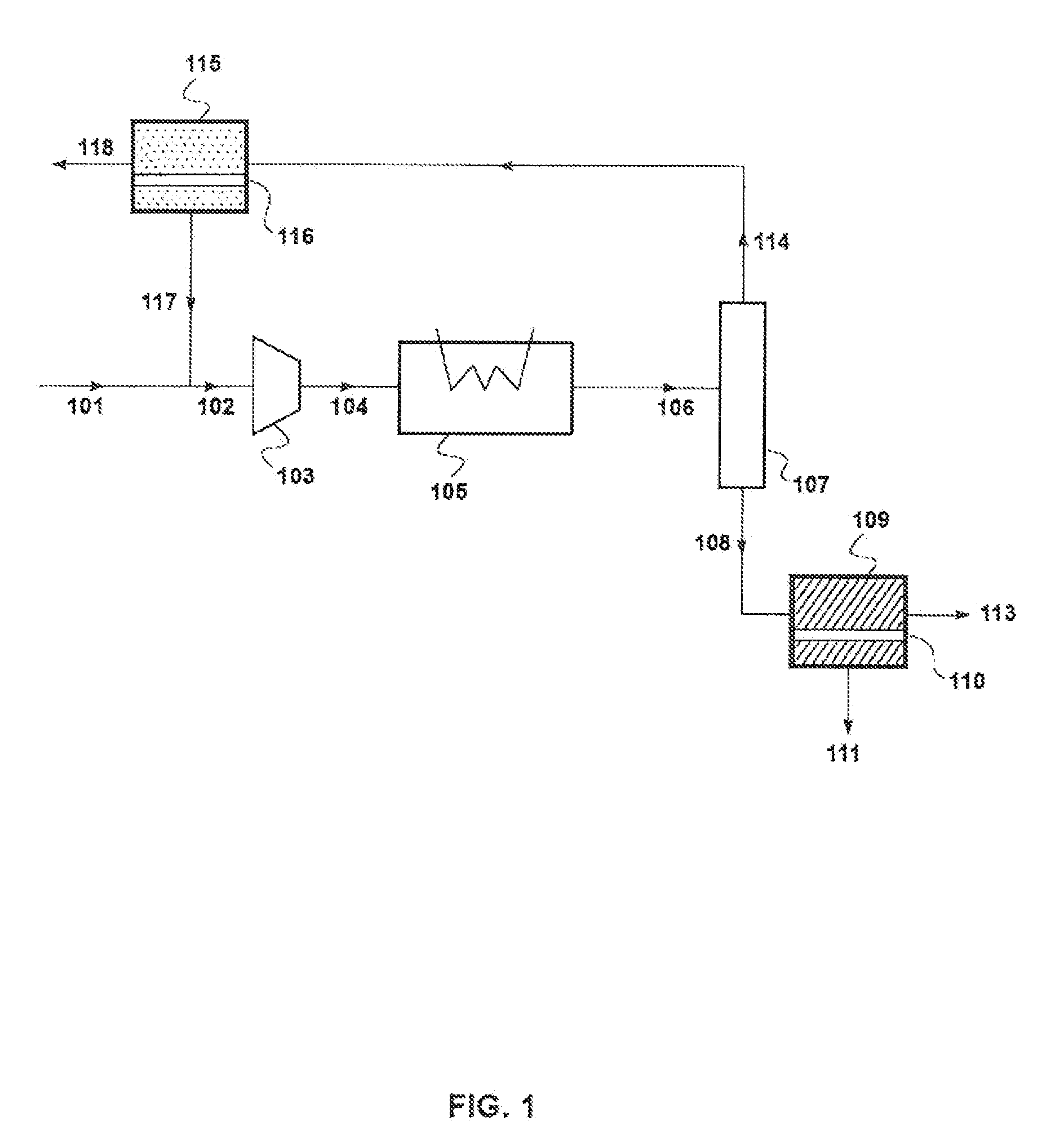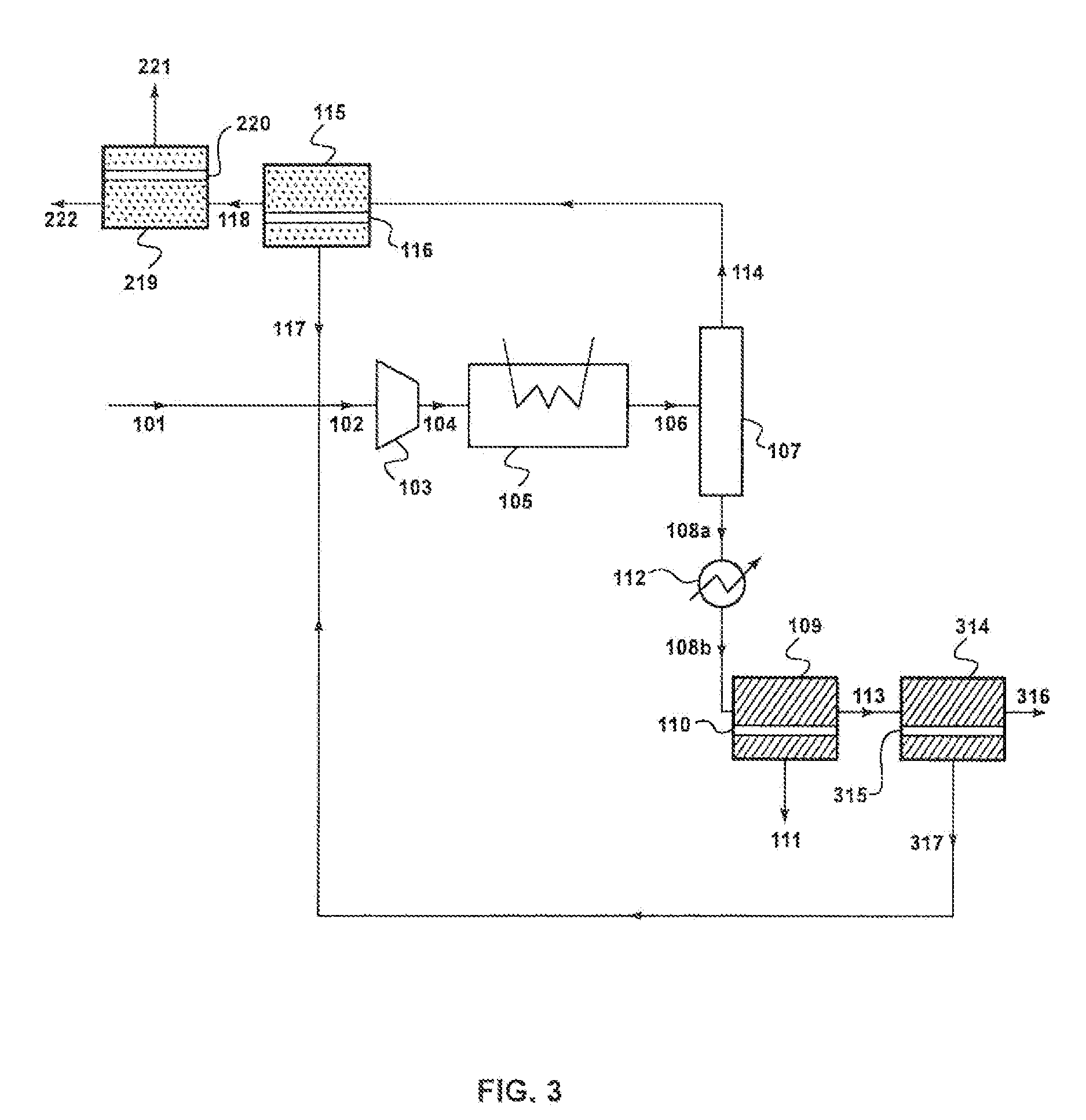Process for Recovering Olefins from Manufacturing Operations
a manufacturing operation and recovery technology, applied in the direction of separation processes, organic chemistry, dispersed particle separation, etc., can solve the problems of unreacted olefins that are typically in the overhead gas, waste, and little instruction on recovering unreacted olefins from the condensed liquid stream
- Summary
- Abstract
- Description
- Claims
- Application Information
AI Technical Summary
Benefits of technology
Problems solved by technology
Method used
Image
Examples
example 1
Treatment of the Uncondensed Gas Stream not in Accordance with the Invention
[0154]For comparison with the following examples, a calculation was performed in a process where only the uncondensed gas stream 114 from separator 107 was treated. In other words, stream 108 was withdrawn from the separator and was not further treated. The treatment included using two membrane separation steps, similar to steps 115 and 219 in FIG. 2. Likewise, the streams are labeled to correspond with the treatment process of the uncondensed gas stream represented in FIG. 2.
[0155]For the calculation, the effluent gas stream was assumed to have a flow rate of 1,139 kg / hour and contain propylene, propane, and nitrogen. It was also assumed that the molar compositions were approximately as follows:
Nitrogen: 76%
Propylene: 21%
Propane: 3%
[0156]It was further assumed that the effluent gas stream was compressed to 24 bara in compression step 103, then cooled to −20° C. in condensation step 105.
[0157]The calculation...
example 2
Olefin Recovery Process in Accordance with the Invention of FIG. 3
[0160]A calculation was performed to model the performance of the process of FIG. 3 in treating an effluent gas stream in a manufacturing operation. The membrane separation of the liquid condensate occurred under pervaporation conditions.
[0161]The results of the calculations are shown in Table 2.
TABLE 2Stream101108a108b111113316317114117118221222Mass1,139805805325480434372,2701,500771135636flow(kg / h)Temp70−204040403829−2028222221(° C.)Pressure1232312221123123323(bara)Component (mol %)Nitrogen75.93.83.80.56.030.03.483.261.299.097.099.5Propylene20.876.576.593.864.97.171.113.830.30.82.50.4Propane3.319.819.85.829.162.925.53.18.50.20.60.1Mass flow (kg / h)Nitrogen77020201199101,737977760129631Propylene3166186183043133310432424954Propane53167167201483111710199211
[0162]Using polymeric membranes to treat the uncondensed gas stream and inorganic membranes to treat the condensate, the process achieves 96% recovery of olefin. The ...
example 3
Olefin Recovery Process in Accordance with the Invention of FIG. 5
[0163]A calculation was performed to model the performance of the process of FIG. 5 in treating an effluent gas stream to recover olefins in a manufacturing operation. The results of the calculations are shown in Table 3.
TABLE 3Stream101108509512513114117118221222Mass flow1,139367367300682,2751,503772135637(kg / h)Temp70−20333129−2028222221(° C.)Pressure12331323123323(bara)Component (mol %)Nitrogen75.93.73.70.816.283.073.799.096.999.5Propylene20.883.183.192.941.015.023.10.82.70.4Propane3.313.213.26.242.82.13.20.10.40.1Mass flow (kg / h)Nitrogen77099281,737976761129632Propylene317307307278294704611054Propane52515120316866111
[0164]Using polymeric membranes to treat the uncondensed gas stream and an inorganic membrane to treat the condensate, the process achieves 88% recovery of olefin. The ratio of propylene to propane in purge stream 513 is reduced to less than 1:1.
PUM
 Login to View More
Login to View More Abstract
Description
Claims
Application Information
 Login to View More
Login to View More - R&D
- Intellectual Property
- Life Sciences
- Materials
- Tech Scout
- Unparalleled Data Quality
- Higher Quality Content
- 60% Fewer Hallucinations
Browse by: Latest US Patents, China's latest patents, Technical Efficacy Thesaurus, Application Domain, Technology Topic, Popular Technical Reports.
© 2025 PatSnap. All rights reserved.Legal|Privacy policy|Modern Slavery Act Transparency Statement|Sitemap|About US| Contact US: help@patsnap.com



